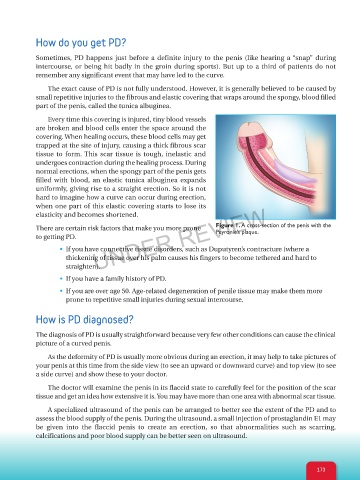Page 172 - Urological Health
P. 172
How do you get PD?
Sometimes, PD happens just before a definite injury to the penis (like hearing a “snap” during
intercourse, or being hit badly in the groin during sports). But up to a third of patients do not
remember any significant event that may have led to the curve.
The exact cause of PD is not fully understood. However, it is generally believed to be caused by
small repetitive injuries to the fibrous and elastic covering that wraps around the spongy, blood filled
part of the penis, called the tunica albuginea.
Every time this covering is injured, tiny blood vessels
are broken and blood cells enter the space around the
covering. When healing occurs, these blood cells may get
trapped at the site of injury, causing a thick fibrous scar
tissue to form. This scar tissue is tough, inelastic and
undergoes contraction during the healing process. During
normal erections, when the spongy part of the penis gets
filled with blood, an elastic tunica albuginea expands
uniformly, giving rise to a straight erection. So it is not
hard to imagine how a curve can occur during erection,
when one part of this elastic covering starts to lose its
elasticity and becomes shortened.
There are certain risk factors that make you more prone Figure 1. A cross-section of the penis with the
Peyronie’s plaque.
to getting PD. UNDER REVIEW
• If you have connective tissue disorders, such as Duputyren’s contracture (where a
thickening of tissue over his palm causes his fingers to become tethered and hard to
straighten).
• If you have a family history of PD.
• If you are over age 50. Age-related degeneration of penile tissue may make them more
prone to repetitive small injuries during sexual intercourse.
How is PD diagnosed?
The diagnosis of PD is usually straightforward because very few other conditions can cause the clinical
picture of a curved penis.
As the deformity of PD is usually more obvious during an erection, it may help to take pictures of
your penis at this time from the side view (to see an upward or downward curve) and top view (to see
a side curve) and show these to your doctor.
The doctor will examine the penis in its flaccid state to carefully feel for the position of the scar
tissue and get an idea how extensive it is.You may have more than one area with abnormal scar tissue.
Aspecialized ultrasound of the penis can be arranged tobetter see the extentof the PD and to
assess the blood supply of the penis. During the ultrasound, a small injection of prostaglandin E1 may
be given into the flaccid penis to create an erection, so that abnormalities such as scarring,
calcifications and poor blood supply can be better seen on ultrasound.
173

